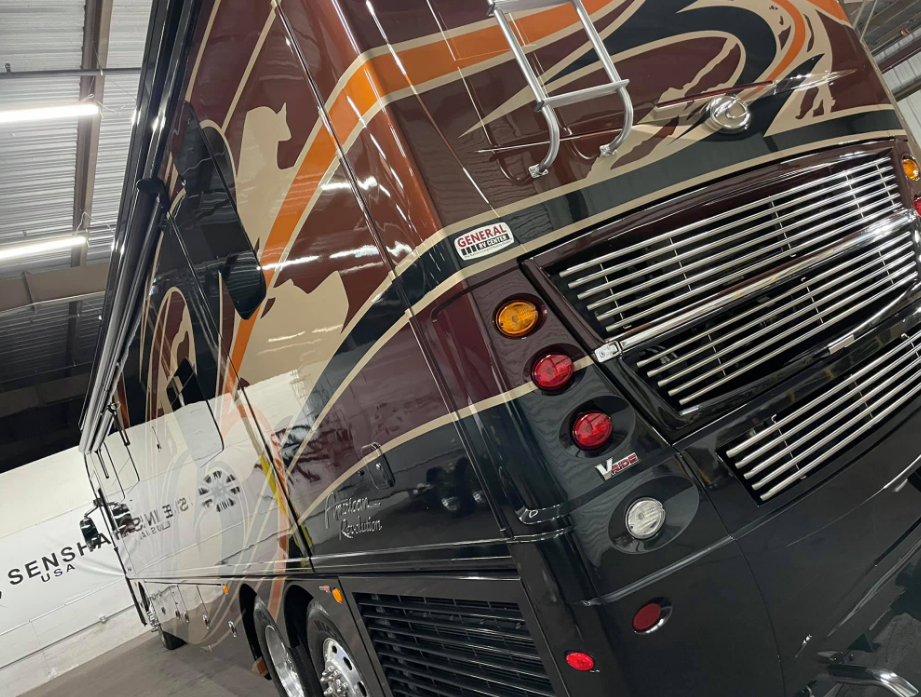
Recreation vehicles, or RVs, have the unlucky fate of being one of the most abused types of vehicles people use in entirely sporadic ways. Where many vehicles are used regularly and often, which triggers maintenance needs and attention to detail. RVs are used seasonally at best and erratically. They are outdoor vehicles, regularly exposed to the elements, and issues are typically only spotted when people use them and have the opportunity to examine the RV closely, usually on a trip. No surprise, RVs suffer far more long-term exposure damage to the elements and poor maintenance as a result, their outer surface layer being one of the most damaged areas. How often have you seen an RV parked at a storage center, simply aging in the sun and wind? It’s a common issue.
RV Bodies Tend to Have a Weaker Finish than Cars
Unlike cars and trucks, which are painted and finished with durable powder coating paint and tough protective clearcoat layer, RVs are typically fabricated with a gelcoat outer layer instead. This particular surfacing is extremely porous, which in turn leads to moisture penetration, stains, and yellowing due to sun and wind exposure. It becomes hard, even impossible to clean an RV with a gelcoat layer as the discoloration sets into the surface layer itself and won’t change back to the stock factory-release white the RV used to have.
Washing and Waxing are Not Enough
The common recommendation for years was to just wax the surface of the RV periodically, which would remove some of the more set-in dirt and topical stains. However, this never really solves the problem of the gelcoat’s porosity.
Instead, a ceramic protective layer is the key difference that can be applied to protect an RV outer surface effectively.

A ceramic coating additive actually works with the existing gelcoat surface, filling in the pores and providing and complete, integrated outer layer that actually protects the RV’s surface completely versus the original Swiss cheese problem.
And, because the ceramic coating approach actually bonds with the existing gelcoat, there’s no issues with peeling, stripping or separation over time. Not only does this provide a far more permanent solution than a periodic waxing, but it also means that an RV owner doesn’t need to keep reapplying it every few weeks, as is the case with wax.
Multiple Benefits With a Ceramic Coating Applied
The benefits of a ceramic RV coating not only address the immediate problem of finally and completely fending off the elements that cause oxidation on an RV surface, it also provides an effective barrier to UV radiation. The glossy surface makes it hard for grit and contaminants to cling to the surface, otherwise creating dirt deposits. No surprise, road grit washes right off instead of getting lodged in nooks and crannies, water itself doesn’t stay on the surface, and the formula involved with ceramic coating allows an RV to retain its shine and gloss much longer.
The Fiberglass RV Body Aspect
While many early RVs were made from aluminum, modern RVs generally have a significant amount of fiberglass making up their structural body and layers. Lightweight, strong, and durable, fiberglass is a go-to material that is shapeable and long-lasting. However, it too can dry out, crack and fragment when not maintained. So, combining fiberglass RVs with a gelcoat outer layer and ceramic coating is an ideal formula, providing the rigidity and lightness fiberglass is famous for, as well as the protective barrier to keep the fiberglass from being damaged, rotted and fragmented over time via exposure.
Focusing on Quality Protection First
One of the best ceramic coating products on the market for finished RV surfaces made of fiberglass tends to be the SiO2 ceramic coating from Sensha. This aftermarket protectant can be applied directly onto a cleaned RV surface, and it will bond directly with the outer layer to enhance its protection of the core fiberglass body underneath. Granted, nobody expects an RV surface coating to magically stop all damage; some basic washing, care and cleaning is still needed regularly with an RV. However, Sensha’s SiO2 ceramic coating application provides an ideal approach to RV surface longevity, particularly in solving the problem of elemental exposure from wind, sun, moisture, and contaminants that otherwise eat away and fiberglass RV bodies over time. An RV should last decades, being functional and durable for getaways, camping and travel.
Contact Bob Moses Ceramic Coating
Don’t let your RV become another age statistic. Utilize a ceramic coating protectant like that from Sensha to prolong the life of your RV before it gets old in the first place. Contact the Bob Moses Ceramic Coating location nearest you today!
